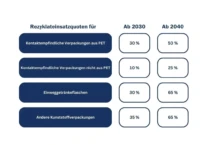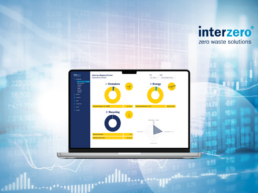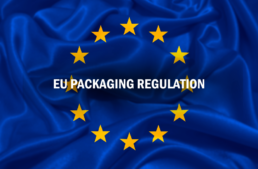The trilogue negotiations, moderated by the European Commission, have been running since the beginning of this year. There have already been a large number of technical meetings at working level. The Belgian EU Council Presidency has worked until recently to find a compromise that is acceptable to all. To achieve this, Belgium has made further changes and clarifications to the text of the political agreement reached on March 4th. These are aimed in particular at reaching a compromise on the regulations regarding the recyclates that count towards the minimum recycled material usage quotas . Recyclates from other EU countries may now also be used if they meet the European quality and sustainability requirements for recycled materials. The Commission proposal provides for the mandatory use of recycled materials (Article 7 on the use of recycled plastics) from consumer waste in every plastic packaging unit from 2030. Here is the table with the preliminary agreement on the minimum recycled material usage levels:

Recyclable packaging (Article 6)
From January 1, 2030, all packaging should be designed to be recyclable, and from 2035, it should also be collected, sorted and recycled using established procedures to a specified minimum extent. In addition, the packaging is divided into 3 recycling classes AC , with A representing a recyclability of more than 95% and class C representing a recyclability of less than or equal to 70%. If packaging falls below this value of 70% from 2030, it may no longer be placed on the European market. (However, there will be transition periods and exceptions)
In addition to this classification , the license fee to be paid (EPR fee) will be dependent on the recyclability of the packaging placed on the market. This is also known as eco-modulation.
Compostable packaging (Article 8)
According to the Commission’s proposal, fruit and vegetable labels and coffee and tea filters and pads must be industrially compostable within two years of coming into force because it is difficult to separate the packaging from the actual organic waste and there is therefore a not insignificant risk that the packaging will also be disposed of in the organic waste. The Council and Parliament agree with this. The European Parliament also wants to introduce the possibility of home composting of this packaging. The Commission and Parliament also envisage the industrial compostability of very light plastic carrier bags after two or three years, although the Council wants to leave this decision to the Member States. The decision as to whether or not compostable packaging should be subject to separate collection as organic waste is to be made by the Member States themselves in accordance with Article 22(1) of the Waste Framework Directive. There is also already agreement that all packaging other than those mentioned (including biodegradable or compostable packaging) must be recycling-ready three years after the Packaging Ordinance comes into force, without affecting the recyclability of other waste streams.
labelling of packaging (Article 11)
The agreement stipulates that three years after the entry into force of the regulation, packaging placed on the market must be provided with a label containing information on the material composition . This will make it easier for consumers to collect separately. The label must be based on pictograms and be easy to understand. Transport packaging is exempt, except for electronic packaging . In addition to the label, a QR code or other digital data carrier can be attached to the packaging. One and a half years after the PPWR comes into force, the Commission will adopt implementing acts laying down a harmonised label and specifications for the labelling requirements and formats.
The trilogue negotiations between the EU Council, the EU Parliament and the EU Commission have been concluded . The next steps are the vote in the plenary session of the Parliament. This will then be decided in the Environment Council before it is published in the EU Official Journal. This is to be applied after a 10-month implementation period . Do you have any questions about the new PPWR Regulation or do you need support with implementation? Our sustainability experts are happy to help you. Contact us now for detailed advice!
Latest news:

With IES to profitable and sustainable business models!
Interzero transforms waste into value

WIN-WIN Interzero @IFAT Munich 2024
Let’s shape the circular economy together!

SAVE THE DATE: Webinar
How the Environmental Sustainability Dashboard supports your sustainability goals
About Interzero:
Interzero is one of the leading service providers around the closure of product, material and logistics loops as well as innovation leader in plastics recycling with the largest sorting capacity in Europe. Under the guiding principle of “zero waste solutions,” the company supports more than 50,000 customers across Europe in the responsible use of recyclable materials, helping them to improve their own sustainability performance and conserve primary resources. With around 2,000 employees, the company generates sales of over one billion euros (2021). According to Fraunhofer UMSICHT, Interzero’s recycling activities saved one million tons of greenhouse gases compared to primary production and over 8.7 million tons of primary raw materials in 2022 alone. For more information, visit www.interzero.at.
Find out more in our latest brochure on “resources SAVED by recycling”.

